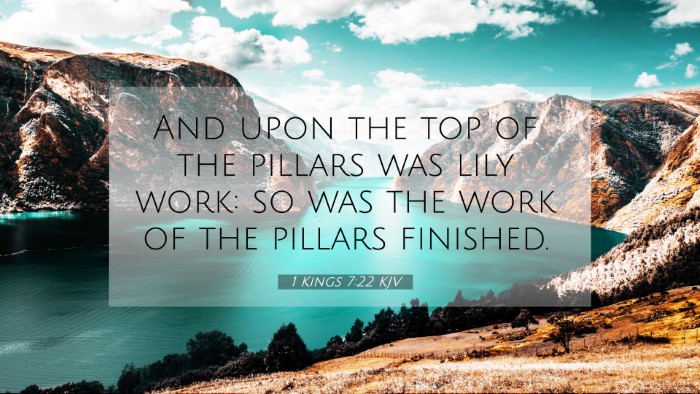Understanding 1 Kings 7:22
Verse: "And upon the top of the pillars was lily work: so was the work of the pillars finished." (1 Kings 7:22)
Overview of Biblical Significance
This verse details the conclusion of the artistic work on the pillars of Solomon's temple, particularly highlighting the intricate design resembling lilies. It serves as a representation of beauty and meticulous craftsmanship in the service of God. The description found here is rich in symbolism and theological implications, serving as an invitation to delve deeper into the meanings behind these structures.
Commentary Insights
The insights provided by respected commentaries deepen our understanding of this verse:
- Matthew Henry: Henry notes that the lilies symbolize purity and holiness, which are key themes in the sanctuary of the Lord. The completion of the pillars signifies the fulfillment of God's promises, as the temple is a dwelling place for His presence.
- Albert Barnes: Barnes emphasizes the architectural significance, discussing how Solomon’s work exemplified the wisdom and majesty of God. He connects the lilies to the idea of resurrection and new life, suggesting that these motifs are present to encourage worshippers.
- Adam Clarke: Clarke focuses on the number and placement of the pillars, asserting their role in enhancing the temple's glory. He interprets the lily work as a decorative flourish that represents the refinement and beauty of God's house.
Thematic Connections
This verse sets a foundation for understanding various themes throughout Scripture, particularly around the concepts of beauty, craftsmanship in worship, and God's dwelling among His people. Here are thematic connections and cross-references:
- Exodus 26:31-33: God's instructions for the tabernacle's design, parallel to the grandeur of the temple.
- 1 Chronicles 28:11-12: The details given to David regarding temple construction, showcasing divinely inspired structure.
- 2 Chronicles 3:5: Further details on the interior of the temple, reinforcing the connection to ornamental craftsmanship.
- Isaiah 61:10: The theme of God's beauty associated with His people echoes the ornamental motifs found in the temple.
- Matthew 6:28-30: Jesus highlights the beauty of the lilies in the field, drawing a connection between natural beauty and divine provision.
- Revelation 21:18-19: The New Jerusalem described with stunning materials parallels the ornate details of the temple.
- Psalms 27:4: The desire to dwell in the house of the Lord contributes to an understanding of worship environments.
Inter-Biblical Dialogue
1 Kings 7:22 fits into a broader inter-Biblical dialogue about God's presence and the significance of the temple. It is essential in recognizing how the Old Testament sets a foundation for the New Testament understanding of God's dwelling among humanity.
Cross-Referencing and Comparative Analysis
Useful Tools for Bible Cross-Referencing
To study these connections deeply, one can utilize:
- Bible concordances that relate specific verses to one another.
- Bible cross-reference guides to navigate themes and motifs across different books.
- Cross-reference Bible study methods to enhance your understanding and application of scripture.
Types of Connections
The connections between 1 Kings 7:22 and other scriptures facilitate an enriching understanding of Biblical narratives:
- Identifying connections between Old and New Testaments: Recognizing how the temple depicted in 1 Kings leads to the understanding of Christ as the true temple.
- Cross-referenced themes in the Bible: The underlying spirit of craftsmanship found in the temple manifests in different forms, emphasizing God's desire for beauty in worship.
- Detailed cross-reference between Gospels: Examining how gospel writers reflect on the sacredness of space and the divine presence among believers.
Conclusion
1 Kings 7:22 not only illuminates the historical and theological importance of Solomon's temple but also invites believers into deeper reflection about God's presence and beauty in their lives. Through cross-referencing with various scriptures, one can enhance their understanding of temple motifs and their significance in the story of redemption.


